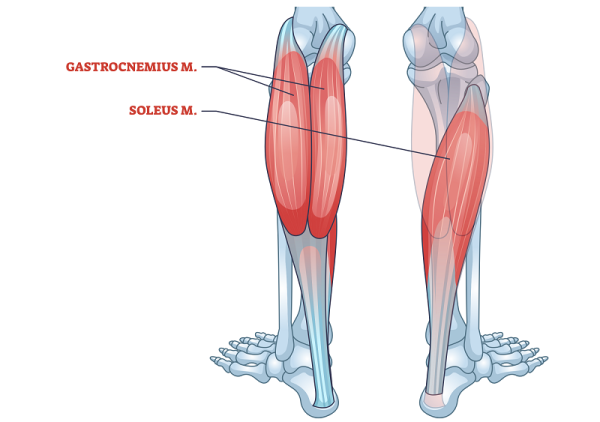Overview
The Standing Barbell Calf Raise is a free-weight isolation exercise that targets the calf muscles, primarily the gastrocnemius and soleus. It involves lifting the heels off an elevated platform while balancing a barbell on the upper back. This movement promotes lower leg muscle growth, ankle stability, and functional strength, making it ideal for bodybuilding, athletic training, and strength conditioning.
How to: Standing Barbell Calf Raise

Setup: Place a sturdy raised platform or step on the floor. Load a barbell and position it across your upper back, as in a back squat.
Foot Position: Step onto the platform so that only the balls of your feet are in contact. Your heels should hang off the edge to allow for a full range of motion.
Body Alignment: Stand upright, keep your core tight, chest up, and shoulders pulled back. Maintain a neutral spine throughout.
Lift Your Heels: Push through the balls of your feet to raise your heels as high as possible, fully contracting your calf muscles.
Pause at the Top: Hold the top position for 1–2 seconds to maximize tension.
Lower Slowly: Lower your heels below the level of the platform in a controlled manner, achieving a full stretch in the calves.
Repeat: Perform the desired number of repetitions with precision and balance.
Tips for Proper Form
Avoid locking your knees: Keep a soft bend to maintain muscular tension and protect joints.
Maintain balance: Engage your core and keep your gaze forward to prevent swaying.
Use a squat pad or towel if the barbell feels uncomfortable on your upper back.
Focus on control: Avoid using momentum—each rep should be deliberate.
Elevate your heels fully: Aim to rise onto the tips of your toes for a complete contraction.
Common Mistakes
Bouncing through reps: Reduces time under tension and risks injury.
Partial range of motion: Limits effectiveness; always lower heels fully.
Poor posture: Slouching or looking down can destabilize your lift.
Excessive barbell weight: Can lead to balance issues and reduce the ability to perform full reps.
Letting heels stay flat: Eliminates the eccentric stretch, reducing gains.
Benefits of the Standing Barbell Calf Raise
Develops calf muscle size and shape: Targets both heads of the gastrocnemius and builds muscular definition.
Increases ankle plantar flexion strength: Essential for sprinting, jumping, and pushing off during walking or running.
Improves balance and stability: Free-weight load challenges the body’s stabilizing muscles.
Promotes joint resilience: Strengthens tendons and ligaments surrounding the ankles and lower leg.
Enhances posture and core control: Upright positioning with a barbell requires trunk and spine engagement.
No specialized equipment required: Can be done with standard gym gear—ideal for home and commercial settings.
Encourages greater muscle activation: Compared to machines, free weights engage more supporting structures.
How to Incorporate Into Your Routine
For Beginners: Start with body weight or an unloaded barbell. Perform 2–3 sets of 10–12 reps while focusing on balance and technique.
For Hypertrophy: Use moderate to heavy loads with 3–4 sets of 12–15 reps. Emphasize peak contraction and full stretch.
For Strength: Use a heavier barbell and perform 4–5 sets of 6–8 controlled reps. Rest 90–120 seconds between sets.
For Endurance and Definition: Perform high reps (15–25) with a lighter load or just body weight. Limit rest to 30–45 seconds.
For Athletic Training: Combine with plyometric drills to enhance explosive power in the lower legs.
For Functional Balance Training: Perform slower reps and include a 2–3 second hold at the top of each lift.
Standing Barbell Calf Raise: Muscles Worked

Frequently Asked Questions
Is this exercise safe for people with lower back issues?
It can be safe if proper posture is maintained and light loads are used, but those with spinal conditions should consult a professional first.
Should I use shoes with a heel or flat shoes?
Flat-soled shoes or barefoot lifting shoes are ideal to maintain ground contact and balance.
Can I substitute this for machine calf raises?
Yes, and it often activates more stabilizers due to the balance requirement.
How high should I raise my heels?
As high as comfortably possible. The goal is full plantar flexion with a strong squeeze at the top.
What if I can’t balance properly?
Start with a lighter weight and perform near a wall or support post until balance improves.
